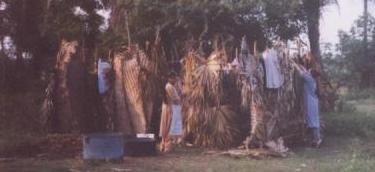I had been very apprehensive to go on this trip, hearing we would not have any proper place to take a bath or use a toilet. Luckily, for us girls, the villagers built us a toilet by digging a hole and sticking a squatter toilet on it. For extra privacy, they built a 'wall' around it, made of banana leaves and stalks, similiar to what you see in the bottom picture.
Many mornings we had to collect water from a well (top picture) which was a ten minute walk from the bathing area, pictured on the bottom. Again, the girls used this 'enclosed' area for bathing, while the boys used an open well some distance away. Every third day, we would wash our clothes at the well and hang them on our 'bathing house' to dry.
|

The local well, used for collecting water and washing clothes.

The girl's open air 'bathing stalls' - used for bathing and hanging clothes to dry.
|
Interesting facts...
Generally in India, villagers feel more comfortable doing bathing and toilet duties in the open, rather than in enclosed, private areas. Also, both women and men in villages do not fully remove their clothes while bathing. Men keep a small cloth tied around their waist and women wear their sari underskirt tied on their chest. Elders may bathe by sitting on a chair.
Although commercialized soaps and detergents are used in villages, many do not use them due to distance to shop and expense. In their place, natural items are used or made for usage. For example, to wash dishes, women use fire ash to clean their metal vessels, dishes, tumblers and few utensils.
|